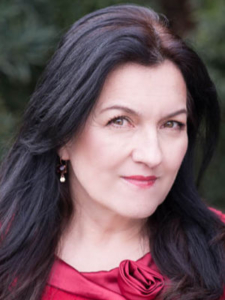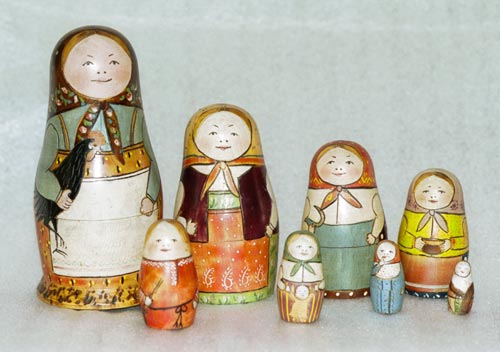
The First Matryoshka Doll set, carved by Vasiliy Zvezdochkin and painted by Malyutin. Sergiev Posad Museum of Toys, Russia
- Nesting Matryoshka dolls were originally created as an homage to family, each doll at home inside a loving matriarch. Now an important part of Russian culture, the first sets were designed as toys. Traditional sets consisted of eight hand-painted pieces: the largest a Babushka, holding a rooster with a headscarf tied under her chin. She came apart to reveal a similar, smaller doll, which opened to reveal another doll, and so on, and so on, and so on, until the tiniest doll—a baby, made of a solid piece of wood—was revealed at the heart. They were designed to simulate mothers who gave birth to daughters: similar but unique, smaller versions of themselves. Today, artists have elevated the craft of Matryoshka to new levels; some even hide secret family symbols or code in the intricate patterns, making the dolls permanent carriers of untold, ancestral stories.
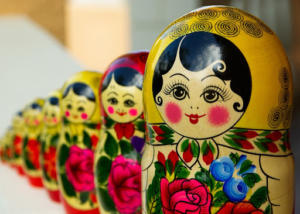
- I bought my first Matryoshka set in 2004 while on vacation in Sitka, Alaska, the former capital of Russian America. My husband, Mario, had gone sport-fishing at dawn, so I hiked Totem Park in the morning and visited some quaint streets in the afternoon. A bookstore displayed a Matryoshka set in the window, next to it was a children’s book: The Littlest Matryoshka by Corinne Demas Bliss. I went inside and read the book from a stool in the corner. In the story, a loving woodcarver named Nikolai creates nesting dolls and paints them by hand. Before he sends them off to be sold, he names each one; the littlest Matryoshka is Nina. Nikolai encourages the largest doll, Anna, to act as the protector of the others: “Keep your sisters safe inside you and may you find a happy home.” From the workshop, the dolls are taken to a store, where they are set up on a display table from biggest to smallest. On a March day, Nina is accidentally knocked from the table by a customer in a puffy coat, kicked across the shop floor into the street, and covered by a layer of snow. Nina’s sisters were unable to lift their painted arms to stop it, unable to open their painted lips to cry for help. Bliss’s storytelling evokes feelings of loss; it’s easy to empathize with the dolls’ pain. Even children understand feelings of panic. Most have felt lost or powerless.

Natasha Lyonne in Russian Doll. Photo: Courtesy of Netflix
- The Netflix show, Russian Doll, premiered in February of 2019, but I saw it for the first time in April. I celebrated meeting a deadline by watching TV, which I don’t normally do. Memories of my own childhood trauma had been unexpectedly resurfacing and I wanted to shut off my brain. Soon, Russian Doll’s narrative opened, like a set of nesting dolls, telling a dense tale of our human psyche. The protagonist, Nadia Vulvokov (played by Natasha Lyonne), is what writers would call —to use a term coined by E.M. Forster—a round character. A wise-cracking, tough New Yorker, she is a walking paradox, engaging in reckless self-indulgence, but exercising rigorous self-protection; she loves her friends and ex-boyfriend, but rejects those closest to her; she pretends not to care about anything, but spends an enormous amount of time looking for her lost cat, Oatmeal. Nadia is a contradiction: protecting a vulnerable, tender self deep inside.Episode one begins in medias res, at Nadia’s 36th birthday party, where she is washing her hands while looking into a mirror in the only bathroom of her friend’s apartment. People waiting are banging on the bathroom door for her to hurry up. Later, Nadia will be hit by a car and die, only to resurrect mid-scene, returning to the sink in the bathroom, to the same place and time, a cycle she will relive several times. Determined to find out why this is happening, she seeks clues to why she’s in this loop—why she keeps dying and waking up again—but it’s hard for her to communicate with others because Nadia’s friends aren’t trapped in the same surreal experience. Frustrated, she shouts, “I’m not crazy!” and as I watch I want to laugh and cry. I root for her to break through, to connect to her friends, her Rabbi, her ex-boyfriend, and strangers. I want someone to believe she’s telling the truth.Like a traditional Matryoshka, Russian Doll has eight parts, episodes that hold pieces of the larger, unfinished, unresolved puzzle that is Nadia’s life.
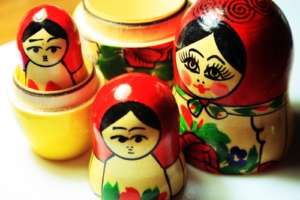
- Watching Russian Doll was a diversion from the intense work of assembling my family’s memoir. My mother’s parents were immigrants from Mexico who made a life here in the USA with their seven children. My Grandma was the Mexican equivalent of a Russian Babushka: a traditional Abuela. She was an apron-wearing, tortilla-making, salsa-canning, feast-producing, cleaning machine. She was also an incredible storyteller, vividly retelling scenes of her childhood in Mexico. My mother is the fifth child of seven and she’s also a storyteller and a keeper of memories. I descended from these women, a storyteller with the same narrative DNA. Some days, when I look in the mirror, I see them look back at me. Our family story is like a set of nesting dolls. Grandma (now deceased), Mom and her siblings (now in their eighties), my siblings and cousins, our children, and my grandchildren each contribute voices to construct our multi-generational story. Lately, I’ve been transcribing interviews of my parents and my Aunties. At first, their stories are about family, swimming, sports, and school. Eventually, they shed their outer layers and share memories of living with loneliness, poverty, an overbearing father, and a feeling of otherness. I’m a carrier of their dreams, joy, pain, and hopes. I also have feelings of otherness, the same desire to be seen, to be valued for who I am deep inside. I participate in the same search for significance in this crazy world, even as it degrades into entropy.

- The Matryoshka dolls I bought looked just like the ones in Bliss’s children’s book. The sales clerk in Sitka warned me not to twist them open, which might break them, and taught me instead to press my thumb gently on their seam as I pulled them apart. I was careful with them, the thin shells of brightly painted wood. The solid, smallest doll looked just like the orphaned Nina in The Littlest Matryoshka, the one who, separated from her sisters, spends most of the story surviving horrific events on her own. The other dolls miss their smallest sister, her phantom presence dwelling inside them like an unfulfilled promise. One day, a young girl, Jessie, sees Anna and her sisters on the sale table. Knowing they’re an incomplete set—she buys them, takes them home, and puts a ball of cotton in the smallest one, so she won’t feel so empty. A series of miracles and spectacular coincidences bring Nina back to her sisters. When they’re reunited, they all smile their painted-on smiles and everyone is happy. The sisters are complete, and with Jessie as their protector, we know they will never be separated again. Writing fiction allows a writer to direct a story; assembling a family history isn’t so easy. I have to find the story among multiple voices; I decide what to include and what to leave out of the book. I’m acutely aware of the differences from generation to generation. Now and then, family stories trigger memories of my sexual abuse or explain environmental factors that let it happen. I listen and transcribe, remembering we all have pain. We’re all so fragile, in our own way.
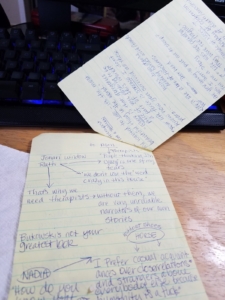
- By the third episode of Russian Doll, I am invested to the point of obsession. Nadia meets Alan, a stranger who is stuck in the same and surreal life and death loop of one day. Together, they try to discover why it’s all happening. I chart recurring themes: addiction, suicide, solitude, mysticism. I look up theories: Johari window, Updike and the Suburban Imaginary, Bukowski, Ecclesiastes. I even look for the children’s book that Nadia loves: Emily of New Moon. Each loop uncovers a layer of story and symbol: running water as newness and mirrors as reflection. Recurring characters are either sages, jesters, rescuers, redeemers, ancestors, or prophets. Recurring truths cause recurring behaviors which cause recurring events. For eight episodes, I have permission to be distracted from the recurring themes of my own narrative.
- Everyone’s family story has many layers. I was one of five children in my immediate family and one of twenty-three cousins—our extended family often celebrated weddings, funerals or holidays together—so I was always seeking attention. When I was the littlest girl, between the ages of five and seven, an extended family member took me into a shower room and molested me. I did what he said because I trusted him, unable to lift my painted arms to stop it, unable to open my painted lips to cry for help. He twisted me open, dropped me, and broke me in half. Later, I started self-medicating to cope with my brokenness, and when I tried to stop these compulsive behaviors, I couldn’t. Stuck in a surreal loop of addictions that almost killed me, until I finally asked for help. Once I did, I found others like me, and I wasn’t alone. Most of my new friends weren’t the kind of people I’d have normally hung out with, but they were real and genuine. I found safety and support in the transparency of these people, hellbent on telling their truths.
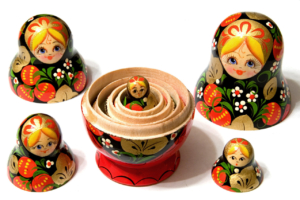
- I used to marvel at the thought—once taught as scientific fact—that females are born with every egg she will ever release into her womb during her lifetime. I imagined myself as a baby, already carrying half of my children’s DNA in my tiny little ovaries, which seemed miraculous. Recently, however, micro-researchers have been further astounded by egg-producing follicles (oogonial stem cells) in female ovaries, which have the power to replace damaged or defective eggs with new ones. Our family nested within one another, our code is written on our twisting double helix, with the built-in power to heal the brokenness inside. This power lived inside my Grandmother when she was just a baby. She carried the promise of my mother inside of her, who carried the promise of me, who carried the promise of my children, long before any of us were born. I carry a Matryoshka pin in my purse: five Russian dolls of descending size, to remind me we are multi-layered, miraculous beings, able to survive terrible pain and still go on to celebrate, and perpetuate life. I read a recent interview with Natasha Lyonne in which she shared a thought: “I think we’d be a much happier species if we could just all admit how broken we are in so many ways. Then we would really discover that we’re actually okay. And that doesn’t mean not participating in life—it means having the freedom to participate in life as you actually are.” Today, I take a deep breath, roll up my sleeves, and get ready to participate in life as I am: broken, but carrying the precious cargo of ancestral stories, deep within myself.
Janet Rodriguez is an author, blogger, teacher, and editor who lives in Sacramento with her husband, extended family, three dogs, and one cat. In the United States, her work has appeared in The Rumpus, Cloud Women’s Quarterly Journal, Salon, American River Review, and Calaveras Station. Rodriguez has also published essays, stories, and two biographies in South Africa. Follow her on Twitter @brazenprincess or her personal blog at www.brazenprincess.com.

